
A shopping mall is a large indoor shopping center, usually anchored by department stores. The term mall originally meant a pedestrian promenade with shops along it, but in the late 1960s, it began to be used as a generic term for the large enclosed shopping centers that were becoming increasingly commonplace. In the United Kingdom and other countries, shopping malls may be called shopping centers.
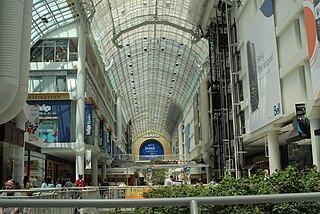
A shopping center, shopping centre, also called a shopping complex, shopping arcade, shopping plaza or galleria, is a group of shops built together, sometimes under one roof.

The Rideau Centre is a three-level shopping centre on Rideau Street in Ottawa, Ontario, Canada. It borders on Rideau Street, the ByWard Market, the Rideau Canal, the Mackenzie King Bridge, and Nicholas Street in Downtown Ottawa. Over 20 million people visit the mall annually. It is the largest shopping mall and the main transit hub in the National Capital Region and the sixth largest mall, by area, in Canada. The Rideau Centre complex has approximately 180 retailers and is connected to a rooftop park, a Westin Hotel, the Shaw Centre, the Freiman Mall and the Major-General George R Pearkes Building.

A strip mall, strip center, strip plaza or simply plaza is a type of shopping center common in North America where the stores are arranged in a row, with a footpath in front. Strip malls are typically developed as a unit and have large parking lots in front. Many of them face major traffic arterials and tend to be self-contained with few pedestrian connections to surrounding neighborhoods. Smaller strip malls may be called mini-malls, while larger ones may be called power centers or big box centers. In 2013, The New York Times reported that the United States had 65,840 strip malls. In 2020, The Wall Street Journal wrote that in the United States, despite the continuing retail apocalypse starting around 2010, investments and visitor numbers were increasing to strip malls.

Yorkdale Shopping Centre, Yorkdale Mall, or simply Yorkdale, is a major retail shopping centre in Toronto, Ontario, Canada. Located at the southwest corner of the interchange between Highway 401 and Allen Road, it opened in 1964 as the largest enclosed shopping mall in the world. Yorkdale is currently the third largest shopping mall in Canada by floor space and has the highest sales per unit area of any mall in Canada, with current merchandise sales levels at roughly CA$1,905 per square foot. At 18 million annual visitors, it is one of the country's busiest malls. Many international retailers have ventured the Canadian market initially at Yorkdale.

The Oracle is a large indoor shopping and leisure mall on the banks of the River Kennet in Reading, Berkshire, England. Partly on the site of a 17th-century workhouse of the same name, it was developed and is owned by a joint venture of Hammerson and the Abu Dhabi Investment Authority.

A big-box store is a physically large retail establishment, usually part of a chain of stores. The term sometimes also refers, by extension, to the company that operates the store. The term "big-box" references the typical appearance of buildings occupied by such stores.
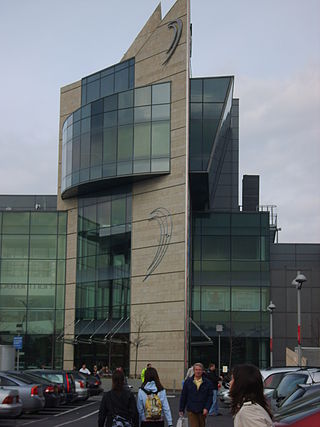
Dundrum Town Centre is a shopping centre located in Dundrum, Dublin, Ireland. It is one of Ireland's two largest shopping centres with over 131 shops, 47 restaurants, 3 amusement facilities and a cinema, retail floor space of 111,484 m2 (1,200,000 sq ft) and almost 140,000 m2 (1,500,000 sq ft) total floor space, and over 3,000 car parking spaces. It is located just south of the centre of the suburban village of Dundrum, within the wider eponymous area. It has annual footfall in excess of 18 million.

A dead mall is a shopping mall with a high vacancy rate or a low consumer traffic level, or that is deteriorating in some manner.
Swansea city centre in Swansea, Wales, contains the main shopping, leisure and nightlife district in Swansea. The city centre covers much of the Castle ward including the area around Oxford Street, Castle Square, and the Quadrant Shopping Centre; Alexandra Road, High Street, Wind Street and the Castle; Parc Tawe; and the Maritime Quarter extending down to the seafront.
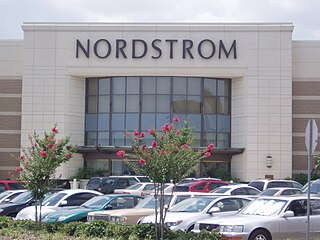
In US retail, an "anchor tenant", sometimes called an "anchor store", "draw tenant", or "key tenant", is a considerably larger tenant in a shopping mall, often a department store or retail chain. They are typically located at the ends of malls, sometimes in the middle. With their broad appeal, they are intended to attract a significant cross-section of the shopping public to the center. They are often offered steep discounts on rent in exchange for signing long-term leases in order to provide steady cash flows for the mall owners. Some examples of anchor stores in the United States are: Macy's, Sears, JCPenney, Nordstrom, Neiman Marcus, Saks Fifth Avenue, Dillard's, Kohl's, and Target. And in Canada; Hudson's Bay, Sears (formerly), Target (formerly), Zellers, Nordstrom/Nordstrom Rack (formerly), TJX Companies, Saks Fifth Avenue, Sporting Life.

Freehold Raceway Mall is a super-regional high-end shopping mall located in Freehold Township, in the U.S. state of New Jersey. As of 2020, it was the largest shopping mall in Central Jersey and the state's third largest shopping mall, behind Garden State Plaza in Paramus, and American Dream Meadowlands in East Rutherford. It is located off of U.S. Route 9, Route 33 Business, and County Route 537, opposite the Freehold Raceway.

The Range is a multi-channel retailer selling products in the home, garden, and leisure categories, with over 210 stores in the United Kingdom and Ireland.

Bergen Town Center is a shopping center located in Bergen County, New Jersey, USA. The center consists of both an indoor mall and exterior outlying stores and occupies over 105 acres split between the municipalities of Paramus and Maywood.
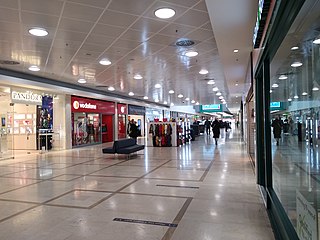
Broadway Shopping Centre is the principal covered shopping centre in the town centre of Bexleyheath and is the largest single covered shopping facility in the London Borough of Bexley.
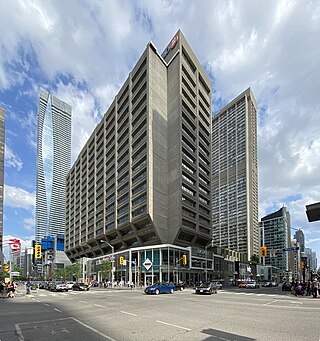
Mink Mile is an upscale shopping district in the neighbourhood of Yorkville in Toronto, Ontario, Canada, along Bloor Street between Yonge Street and Avenue Road.

A power center or big-box center is a shopping center with typically 250,000 to 600,000 square feet of gross leasable area that usually contains three or more big box anchor tenants and various smaller retailers, where the anchors occupy 75–90% of the total area.

A neighborhood shopping center is an industry term in the United States for a shopping center with 30,000 to 125,000 square feet of gross leasable area, typically anchored by a supermarket and/or large drugstore.
The retail format influences the consumer's store choice and addresses the consumer's expectations. At its most basic level, a retail format is a simple marketplace, that is; a location where goods and services are exchanged. In some parts of the world, the retail sector is still dominated by small family-run stores, but large retail chains are increasingly dominating the sector, because they can exert considerable buying power and pass on the savings in the form of lower prices. Many of these large retail chains also produce their own private labels which compete alongside manufacturer brands. Considerable consolidation of retail stores has changed the retail landscape, transferring power away from wholesalers and into the hands of the large retail chains.



















